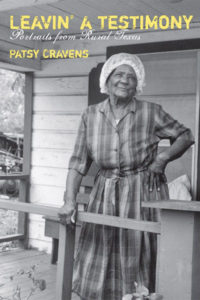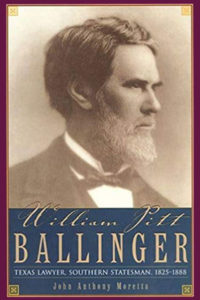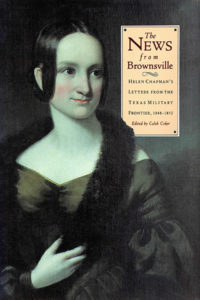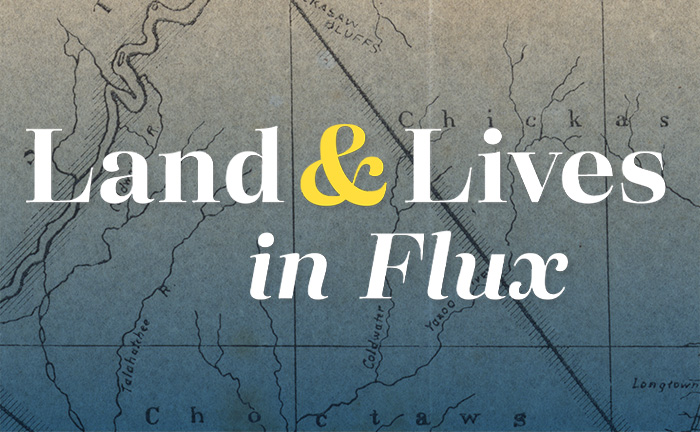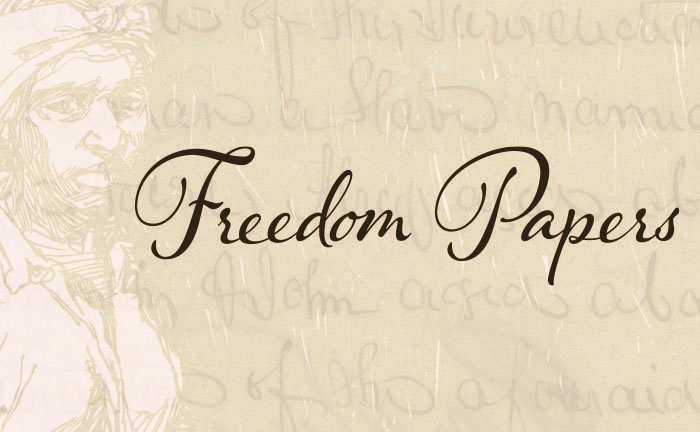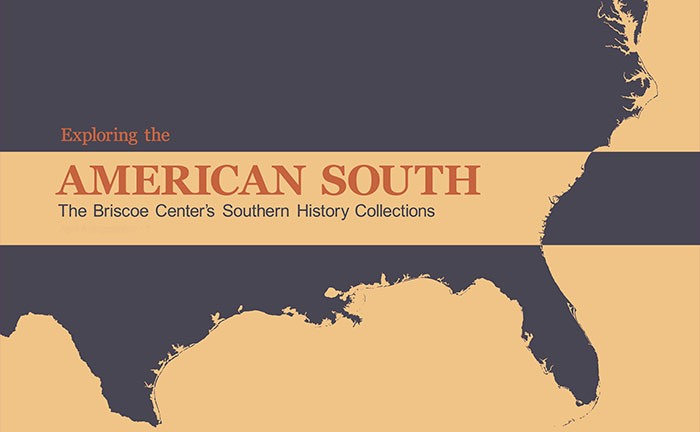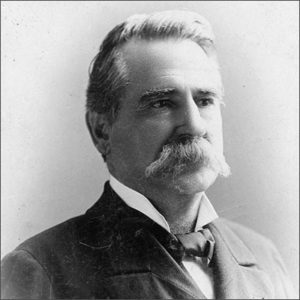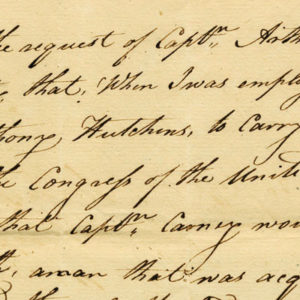The Southern history collections at the Briscoe Center are recognized nationally as one of the major resources for research on the history of the American South, including the eleven states that seceded from the Union in 1860 and 1861. The holdings provide an in-depth understanding of the historical development of the South, with a special emphasis on chattel slavery, the cotton economy, and the Civil War. Also included are comprehensive collections of newspapers from across the South covering the colonial era through Reconstruction and into the Jim Crow era.
In 1985 the Briscoe Center acquired the Natchez Trace Collection, which has become the premier resource at the university for the study of Southern history. It is one of the center’s most significant holdings. Named for the historic route connecting Nashville, Tennessee, with Natchez, Mississippi, the collection is rich in historical materials relating to the Lower Mississippi Valley from the eighteenth to early twentieth century. The materials document the lives of enslaved people, free people of color, and the white elite, including government officials, politicians, soldiers, bankers, jurists, planters, merchants, physicians, clergy, educators, and homemakers who lived in the parishes and counties of Louisiana and Mississippi.
The beginnings of the Southern history collections are found in a bequest from George W. Littlefield, a wealthy rancher and banker who served as a University of Texas regent. He was also a Confederate veteran who had been wounded during the Civil War and who actively subscribed to the “Lost Cause.” In 1914, he approached Eugene C. Barker, chairman of the university’s department of history, to express his concern with what he viewed as the misrepresentation of the South in American history education at the university. Barker subsequently persuaded Littlefield to establish a fund that would enable the university to collect materials on Southern history.
Littlefield’s initial bequest of $25,000 led to the creation of the Littlefield Fund for Southern History. He further strengthened the fund with an additional bequest of $100,000. The collection has grown exponentially over the past century in ways that Littlefield could not have anticipated (and may not have approved of.) Today, it documents Spanish, French, and Anglo colonization of the South, from the Revolution through to Reconstruction, and on into the Jim Crow era—and it is used by scholars of many different backgrounds to write history from a variety of viewpoints and perspectives.
Littlefield Fund for Southern History

After the initial bequest, the Littlefield Fund soon enabled the acquisition of the Samuel H. Stout Papers, which record the Civil War activities of the Confederate medical director of hospitals, Army of Tennessee, as well as a collection of Charleston, South Carolina, newspapers (1796–1910). Other early acquisitions include the records of the William Massie Plantation of Virginia (1797–1917), which include nearly one hundred thousand pages of correspondence and business documents; the Pugh Family Papers (1807–1907), containing more than ten thousand manuscript documents that record plantation life in Louisiana; hundreds of files for nineteenth-century Southern newspapers; and more than forty individual manuscript collections relating to Mississippi, including the Mexican War letters of Vicksburg soldier Charles T. Harlan, the Civil War diary of James Kirkpatrick (1861–64), and the papers of Mississippi senator and judge Powhattan Ellis (1811–36). In addition, the papers of University of Texas professor of history Charles W. Ramsdell document his influential research on the Civil War. A significant component of that research is a set of nearly four hundred reels of microfilmed records for Confederate bureaucracy, soldiers, and politicians, as well as miscellaneous material relating to the general history of the Antebellum, Civil War, and Reconstruction eras in the South. The microfilms were the result of a project sponsored by the Littlefield Fund from 1937 to 1940 that brought together materials on Southern history housed in archival repositories outside of Texas.
Natchez Trace Collection
In 1985 the Briscoe Center acquired the Natchez Trace Collection, which has become the premier resource at the university for the study of Southern history. It is one of the center’s top most significant holdings. Named for the historic route connecting Nashville, Tennessee, with Natchez, Mississippi, the collection is rich in historical materials relating to the Lower Mississippi Valley from the eighteenth to early twentieth century. An anonymous private collector gathered the collection over a period of forty years after the end of World War I.

Discussions for obtaining the material from the collector’s heirs were conducted from 1980 until September of 1984, when Briscoe Center Director Don Carleton, along with professor of history Lewis Gould and university bibliographer Richard Holland, traveled to Mississippi to inspect the collection. After a successful agreement was reached with the owner to purchase the holdings, they were shipped to the center in December 1985.
The more than 450 linear feet of primary resources in the Natchez Trace Collection include personal papers; business, legal, and financial records; photographs; maps; sheet music; newspapers; and pamphlets, broadsides, and diaries. The materials document the lives of enslaved people, government officials and politicians, soldiers, bankers, jurists, planters, merchants, physicians, clergy, educators, free people of color, and homemakers who lived and worked in the parishes and counties of Louisiana and Mississippi. The collection is in fact a compilation of subcollections, in which the manuscripts serve as the foundational core in size and research value. Center staff organized the manuscript subcollections based on individuals, families, businesses, and other organizational divisions.
Texas Connections and Provincial and Territorial Records
The value of the Natchez Trace materials to the center’s Southern History Collection comes in part from their connection to Texas. The Natchez Trace served as a passageway in the 1820s and ’30s for the colonization of Texas, as pioneers made their way from Tennessee through Natchez on their way to settle Texas. Colonists Moses and Stephen F. Austin spent time in the Natchez region, and two letters from Stephen F. Austin are found in the collection, one of which was written on his way to Texas to launch his first colony of white settlers. Among the highlights of the Natchez Trace manuscripts are two collections with links to Texas. The first of those holdings is the Richard T. Archer Family Papers (1790–1910), which concerns the Archer family and plantations in Claiborne County, Mississippi, and includes letters from Branch T. Archer, who was a leader in the Texas Revolution. The second collection contains the John A. Quitman Papers (1820s–1860s), which detail the legal and financial affairs of Quitman, an important Mississippi attorney, elected official, and volunteer in the Texas Revolution.

Other significant papers in the Natchez Trace manuscripts include the Barnes-Wills Family Papers (1783–1840), which chronicle a family of merchants and land speculators in Port Gibson, Mississippi, and the James Campbell Wilkins Papers (1801–52), which record the life of a major Natchez merchant and politician.
Among the many special subcollections in the holdings is a set of Provincial and Territorial Records (1759–1813), specifically civil court records and legal and administrative documents relating to the French and Spanish colonial and Louisiana and Mississippi territorial eras. Those documents include correspondence; land surveys; marriage contracts; sales and manumissions of enslaved people; wills; and petitions from Natchez, Ouachita, Iberville, and many other jurisdictions. Some of the documents are written in differing combinations of English, French, and Spanish, depending on when and in which jurisdiction they were created.
Chattel Slavery, Plantations, Steamboats, the Civil War and Reconstruction, and Business Collections
Other significant subcollections focus on chattel slavery, plantations, steamboats, the Civil War and Reconstruction, and business. The Natchez Trace Slaves and Slavery Collection (1793–1864) contains legal documents, bills of sale, indentures, manumission papers, records of people who fled enslavement, and other materials relating to almost every aspect of slavery in Louisiana, Mississippi, and other states.
In Her Own Words
The Plantation Collection (1810s–1890s) offers miscellaneous ledgers and papers documenting activities on various plantations in Mississippi and Louisiana, including Lake Providence, Dearmond, Armat, Freeland, Goldman, Walnut Grove, Oakgrove, Whitaker, and Killarney.

The Mississippi River Steamboat Collection (1806–1925) contains receipts, bills, legal records, correspondence, printed materials, and ledgers documenting the impact of steam travel and commerce on the lower Mississippi and its tributaries. Among the steamboat materials from the 1830s are ledgers registering the embarkation of passengers bound for Texas. The Civil War and Reconstruction Collection (1860s) contains the correspondence of Confederate soldiers, printed military orders, guard and picket passes, Confederate government printed forms, amnesty oaths, Freedmen’s Bureau forms, and Reconstruction government documents and orders relating to the war and its aftermath in Louisiana and Mississippi. The Business Collection (1790s–1900s) features nine linear feet of ledgers, account books, inventories, receipts, and miscellaneous materials relating to merchants, cotton factories, and various other business activities in the lower Mississippi River Valley.
Photograph, Map, Ephemera, Pamphlet, and Sheet Music Collections

Other subcollections are grouped by special format. They include the Photograph Collection (ca. 1855–1920), which contains more than 870 images, including daguerreotypes, lantern slides, cartes-de-visite portraits, stereographs, tintypes, and postcards depicting families, scenes, and commercial views from the Natchez and Vicksburg areas. Prominent New Orleans, Natchez, and Vicksburg photographers made many of those images. The Natchez Trace Newspaper Collection holds more than 200 newspaper titles from nineteen states, with special strengths in pre–Civil War–era papers from towns and cities in Louisiana and Mississippi. Among those newspapers are rare issues of The Louisiana Gazette and Arcadia and La Fourche Advertiser. All of the newspapers in the collection were cataloged into the Online Computer Library Center as part of the center’s NEH-funded Texas Newspaper Project.

The Map Collection contains 138 manuscript and printed maps depicting nineteenth-century Louisiana and Mississippi, especially before the Civil War. Cartographic types include land surveys and plat maps, atlases, pocket maps and city guides, and specialty maps, such as Civil War battle and railroad route maps. The Natchez Trace Ephemera Collection (1785–1930) features 300 items of broadsides, advertisements, tickets, ballots, menus, programs, invitations, greeting cards, funeral announcements, and other materials relating to politics; chattel slavery; real estate; law; education; agriculture; economic, social, and cultural affairs; and everyday life in Louisiana and Mississippi. The Pamphlet Collection (1790s–1900s) contains an array of more than 500 nineteenth-century government and college publications, mail-order catalogs, scientific brochures, magazines, political and religious tracts, and popular literature representing the leisure and professional reading of individuals and organizations whose papers are represented in the Natchez Trace Collection.

Finally, the Natchez Trace Sheet Music Collection (1840s–1900s) provides some 3,500 pieces of music cultivated in Southern households or issued by Southern music publishers, such as the A. E. Blackmar firm in New Orleans. Important items in the Sheet Music Collection include original editions of Stephen Foster’s compositions as well as other parlor music, Civil War songs, minstrel songs, show tunes, and jubilee songs. Many of the music imprints feature cover art that often reflects the social values of white society at the time. While troubling today, they represent important primary sources that document the long history of racism in popular culture.
Collection Development
In 2011 the Briscoe Center expanded the Natchez Trace Collection with a significant archival collection containing more than 185 letters, legal documents, and manuscripts related to the colonization, settlement, and economy of the Lower Mississippi region, with items from the late 1700s to the mid-1800s. The archival materials in the acquisition represent a wide range of themes related to the social, economic, and political history of the region. American slavery is well documented in the papers, including legal documents, ledger books, newspapers featuring “fugitive slave” notices and countless letters, many with vivid descriptions of both the enslaved and their enslavers. The collection also includes important documentation of the Southern Antebellum economy, notably the cotton and tobacco trade and agricultural technology. The center also acquired a plantation overseer’s ledger as well as an inventory of enslaved people from the Frogmore Plantation in Louisiana.

Since the acquisition of the Natchez Trace Collection in 1985, the Dolph Briscoe Center for American History has promoted the collection’s use through staff presentations, publications, and exhibitions, and through public lectures by scholars who use its resources. Inside the Natchez Trace Collection: New Sources for Southern History (1999), is a compilation of essays on research areas supported by materials in the collection, including women’s history, the history of the Natchez District, Antebellum politics, economic history and elite planters, and the experiences of enslaved people. The 2017 exhibition Exploring the American South: The Briscoe Center’s Southern History Collections revealed the Southern American story across the 19th century—a time of great transformation for the people, government, and ways of life in the region with special emphasis on slavery, the cotton economy, and the Civil War.
Adapted from The Collections: The University of Texas at Austin, 2015. Updated 2020.
Our collections inspire our own projects, including books, exhibits, programs, films, and educational materials.
Banner image: Joseph Henry, circa 1900. Natchez Trace Collection, Photographs Collection. Image detail from ntc_0047.


